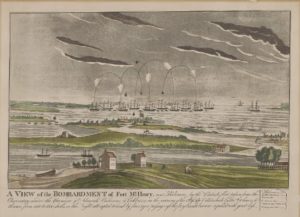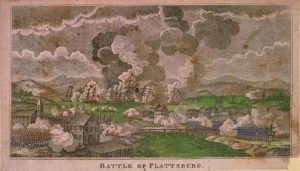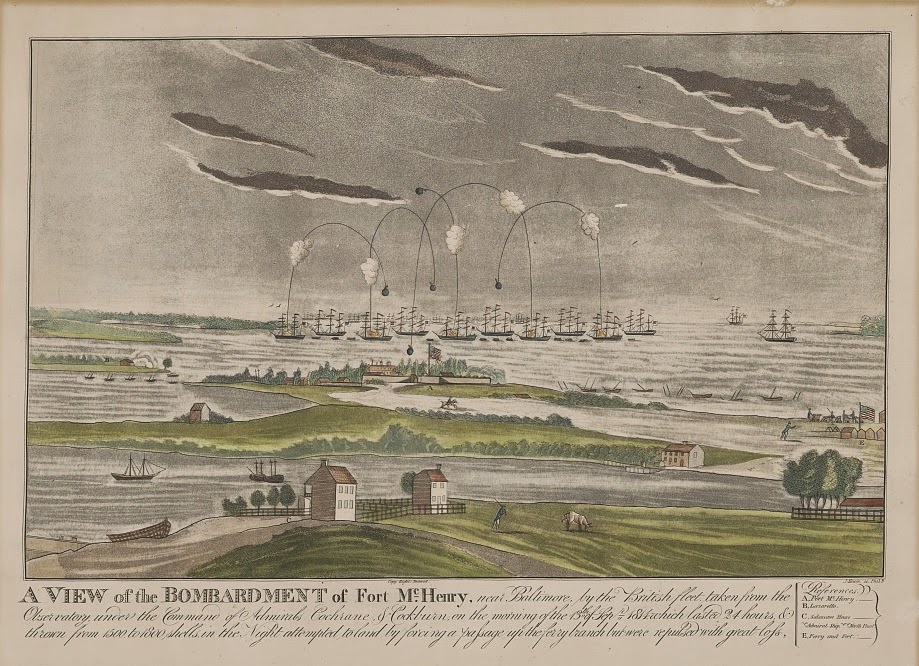The second week of September 1814 was an ominous time for the United States. The public buildings at Washington, including the Capitol, White House, Treasury, and Navy Yard lay in ashes, and the British had set their sights on the commercial city of Baltimore. According to British Vice Admiral Alexander Cochrane, who commanded the British fleet in the Chesapeake, Americans “like Spaniels … must be treated with great severity before you ever make them tractable.” And so he wished to destroy Baltimore, “the most democratic town &I believe the richest in the Country.”
No longer in doubt as to the capabilities of the British Army and Navy, the citizens of Baltimore, state militia, and US Navy sailors worked day and night to fortify the approaches to the city. By the 12th of September, they’d protected the town. A star-shaped bastion called Fort McHenry, strategically placed at the entrance to the northwest branch of the Patapsco River and the inner harbor, formed the centerpiece of a string of forts and batteries designed to turn back even the most determined attack.

As we know, despite a land attack from the east and a naval bombardment, during which they hurled almost 2000 bomb shells and 800 rockets at Fort McHenry, the British failed to breech the defenses and retired down the bay without taking the town. According to American Lt. Henry Newcomb, who commanded a contingent of US Navy sailors at one of the batteries west of Fort McHenry, “the seamen were extremely indignant that the enemy fought no longer.”
Meanwhile, 500 miles to the north, American seamen faced another onslaught from a combined British army and navy attack. In the late summer, a British force of 10,000 under the command of General Sir George Prevost moved down the Champlain Valley, intent on invading the United States. A British fleet had been assembled in the upper reaches of the lake, and its commander George Downie, was tasked with gaining control of Lake Champlain and protecting the army’s flank and supply lines.
Facing this large force was Brigadier General Alexander Macomb, with 3,000 American soldiers at Plattsburgh, NY. On Lake Champlain, Master Commandant Thomas MacDonough had a sloop-of-war, a schooner, two brigs and 12 gunboats at his command. The ships arrived at Plattsburgh on September 3.
On September 11 Downie’s fleet, delayed by outfitting the frigate Confiance, finally caught up with Prevost’s army, then near Plattsburgh. MacDonough had cleverly moored his ships bow to stern across the entrance to Plattsburgh (or Cumberland) Bay. The crews ran “springs” or heavy cables from the ships’ sterns to the anchors forward. By hauling in on these spring lines, the men could turn the ships’ broadsides in a wide arc.
About 9 AM the British came round Cumberland Head and anchored opposite the American line. A little before 10 AM the battle began in earnest. The fierce battle proved destructive to both ships and men. Early in the action, an American cannonball struck the muzzle of a gun on the Confiance, knocking it from its carriage and against Downie’s groin. A later account described the condition of his body: “His skin was not broken, a black mark about the size of a small plate was the only visible injury. His watch was found flattened, with its hands pointing to the very second at which he received the fatal blow.”

MacDonough’s report to the Secretary of the Navy gives testimony to the fierceness of the action: “[T]here was not a Mast in either squadron that could stand to make sail on; the lower rigging, being nearly all shot away, hung down as though it had been just placed over the mastheads…. The Saratoga had Fifty five round Shot in her Hull- the Confiance One hundred & five. – The Enemy’s shot passed principally just over our heads, as there were not 20 whole hammocks in the nettings at the close of the action.”
A Midshipman Lee of the Confiance described the conditions on the British ships: “The havoc on both sides is dreadful. I don’t think there are more than five of our men out of three hundred but what are killed or wounded. Never was a shower of hail so thick as the shot whistling about our ears. Were you to see my jacket, waistcoat and trousers, you would be astonished how I escaped as I did, for they are literally torn all to rags with shot and splinters; the upper part of my hat was also shot away. There is one of our marines who was in the Trafalgar action with Lord Nelson who says it was a mere flea-bite in comparison with this.”
With their crews decimated and sails and rigging shot away, the British vessels surrendered one by one. A number of the gunboats pulled away from the battle and escaped, but in the end it was a decisive victory for the Americans. In imitation of Oliver Hazard Perry’s famous “We have met the enemy” message after the Battle of Lake Erie, MacDonough wrote a short message to the Secretary of the Navy announcing his victory:
“The Almighty has been pleased to Grant us a signal victory on Lake Champlain in the capture of one Frigate, one Brig, and two sloops of war of the enemy.”
The victories at Baltimore and Plattsburgh not only secured the safety of the respective regions, but they denied the British a bargaining chip in the ongoing peace negotiations at Ghent. British territorial gains were minimized, and therefore could not be used to gain concessions from American negotiators.
The Author(s)
Matthew Brenckle
Research Historian, USS Constitution Museum
Matthew Brenckle was the Research Historian at the USS Constitution Museum from 2006 to 2016.
